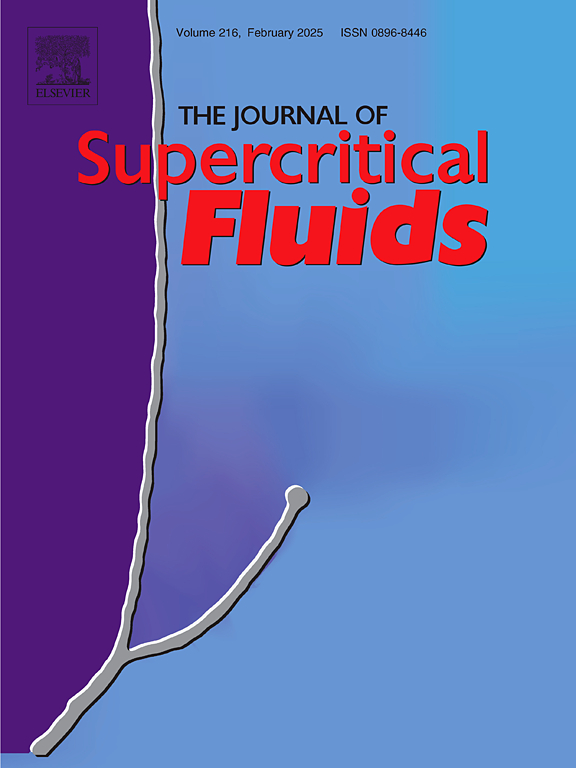Thermodynamic consistency assessment and modeling of methane and carbon dioxide hydrates dissociation conditions in the presence of deep eutectic solvents as eco-friendly inhibitors
IF 4.4
3区 工程技术
Q2 CHEMISTRY, PHYSICAL
引用次数: 0
Abstract
The formation of gas hydrates in gas-dominated pipelines results in flow assurance challenges, potentially leading to blockages, production interruptions, equipment malfunctions, and financial losses. This study presents a comprehensive thermodynamic modeling framework to calculate methane and carbon dioxide hydrates dissociation conditions in the presence of deep eutectic solvent (DES) aqueous solution as promising thermodynamic hydrate inhibitor. A modified van der Waals-Platteeuw (vdW-P) model is utilized for the hydrate phase, combined with the Peng-Robinson (PR) equation of state for the gas/vapor phase. Water activity is calculated employing a combination of Flory-Huggins (FH), NRTL, or UNIQUAC models for short-range molecular interactions and the Pitzer model for long-range ionic effects. A database of 80 experimental hydrate dissociation conditions points across eight DES systems is then analyzed. All three modeling packages yield average absolute deviations (AAD) below 1 K, with the (vdW-P + PR + FH + Pitzer) model achieving the lowest AAD of 0.46 K after thermodynamic consistency screening. Thermodynamic consistency tests reveal that only 12 out of the 80 data points fully satisfy all three criteria (Clausius–Clapeyron linearity, enthalpy consistency, and water activity stability), which indicates potential limitations in experimental data reliability. The study presents a robust and validated modeling tool for calculating hydrate phase equilibrium in DES-containing systems, highlighting the importance of consistency tests in assessing experimental data quality.
深层共晶溶剂作为生态友好抑制剂存在下甲烷和二氧化碳水合物解离条件的热力学一致性评估和建模
在以天然气为主的管道中,天然气水合物的形成给流动保障带来了挑战,可能导致管道堵塞、生产中断、设备故障和经济损失。本研究提出了一个综合的热力学模型框架来计算甲烷和二氧化碳水合物在深共熔溶剂(DES)水溶液存在下的解离条件。水合物相采用改进的van der Waals-Platteeuw (vdW-P)模型,气相采用Peng-Robinson (PR)状态方程。水活度的计算采用了flury - huggins (FH)、NRTL或UNIQUAC模型(用于短程分子相互作用)和Pitzer模型(用于远距离离子效应)的组合。然后分析了8个DES系统中80个实验水合物解离条件点的数据库。三个建模包的平均绝对偏差(AAD)均低于1K,其中(vdW-P + PR + FH + Pitzer)模型经过热力学一致性筛选后的AAD最低,为0.46K。热力学一致性测试显示,80个数据点中只有12个完全满足所有三个标准(Clausius-Clapeyron线性、焓一致性和水活度稳定性),这表明实验数据可靠性存在潜在局限性。该研究为含des体系的水合物计算提供了一个鲁棒且经过验证的建模工具,并强调了一致性测试在评估实验数据质量方面的价值。
本文章由计算机程序翻译,如有差异,请以英文原文为准。
求助全文
约1分钟内获得全文
求助全文
来源期刊

Journal of Supercritical Fluids
工程技术-工程:化工
CiteScore
7.60
自引率
10.30%
发文量
236
审稿时长
56 days
期刊介绍:
The Journal of Supercritical Fluids is an international journal devoted to the fundamental and applied aspects of supercritical fluids and processes. Its aim is to provide a focused platform for academic and industrial researchers to report their findings and to have ready access to the advances in this rapidly growing field. Its coverage is multidisciplinary and includes both basic and applied topics.
Thermodynamics and phase equilibria, reaction kinetics and rate processes, thermal and transport properties, and all topics related to processing such as separations (extraction, fractionation, purification, chromatography) nucleation and impregnation are within the scope. Accounts of specific engineering applications such as those encountered in food, fuel, natural products, minerals, pharmaceuticals and polymer industries are included. Topics related to high pressure equipment design, analytical techniques, sensors, and process control methodologies are also within the scope of the journal.
 求助内容:
求助内容: 应助结果提醒方式:
应助结果提醒方式:


